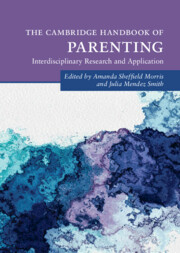Book contents
- The Cambridge Handbook of Parenting
- Cambridge Handbooks in Psychology
- The Cambridge Handbook of Parenting
- Copyright page
- Dedication
- Contents
- Contributors
- Figures
- Tables
- Introduction
- Part I Foundations of Parenting
- 1 Foundational Theories and the Establishment of Parenting Science Research
- 2 Parenting, Challenges, Brain Development, and Attachment Strategies
- 3 Parenting and Brain Development
- 4 Parenting and Children’s Social and Emotional Development: Emotion Socialization across Childhood and Adolescence
- 5 Parents Matter: The Cornerstone for Children’s Cognitive and Language Development
- 6 Discipline and Punishment in Child Development
- 7 Parenting From a Cultural and Global Perspective: A Review of Theoretical Models and Parenting Research in Diverse Cultural Contexts
- Part II Parenting across Development: Social, Emotional, and Cognitive Influences
- Part III Parental Factors That Impact Parenting
- Part IV Child Factors that Impact Parenting
- Part V Parent Education, Intervention and Policy
- Index
- References
5 - Parents Matter: The Cornerstone for Children’s Cognitive and Language Development
from Part I - Foundations of Parenting
Published online by Cambridge University Press: 01 December 2022
- The Cambridge Handbook of Parenting
- Cambridge Handbooks in Psychology
- The Cambridge Handbook of Parenting
- Copyright page
- Dedication
- Contents
- Contributors
- Figures
- Tables
- Introduction
- Part I Foundations of Parenting
- 1 Foundational Theories and the Establishment of Parenting Science Research
- 2 Parenting, Challenges, Brain Development, and Attachment Strategies
- 3 Parenting and Brain Development
- 4 Parenting and Children’s Social and Emotional Development: Emotion Socialization across Childhood and Adolescence
- 5 Parents Matter: The Cornerstone for Children’s Cognitive and Language Development
- 6 Discipline and Punishment in Child Development
- 7 Parenting From a Cultural and Global Perspective: A Review of Theoretical Models and Parenting Research in Diverse Cultural Contexts
- Part II Parenting across Development: Social, Emotional, and Cognitive Influences
- Part III Parental Factors That Impact Parenting
- Part IV Child Factors that Impact Parenting
- Part V Parent Education, Intervention and Policy
- Index
- References
Summary
Parents support their children’s language and cognitive development through everyday, informal learning opportunities. We discuss how parents can capitalize on current research and theories of children’s development to cultivate the foundational skills needed to succeed in the twenty-first century. We first examine how children learn; specifically, how being active, engaged, meaningful, socially interactive, and joyful leads to optimal learning. We then discuss the 6 Cs (collaboration, communication, content, critical thinking, creativity, and confidence), or what children learn, and how parents can play a central role in supporting their children’ development of these skills.
Keywords
- Type
- Chapter
- Information
- The Cambridge Handbook of Parenting , pp. 95 - 119Publisher: Cambridge University PressPrint publication year: 2022

